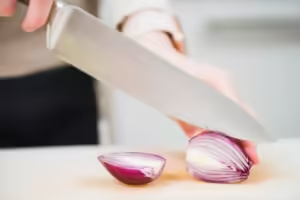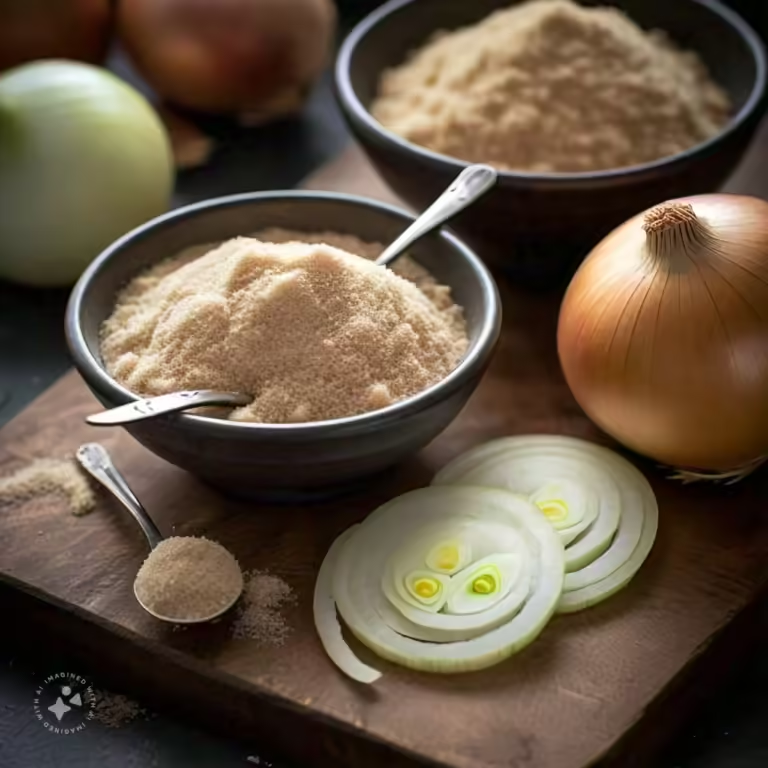Table of Contents
Onions are one of the most commonly used ingredients in kitchens worldwide, and knowing how to dice an onion is an essential skill for any home cook.
Whether you’re preparing a savory stew, a fresh salad, or a delicious stir-fry, properly diced onions not only enhance the flavor but also make your dishes visually appealing and easier to cook.
However, many people struggle with this simple task. Between tears streaming down your face and uneven cuts, dicing an onion can sometimes feel more like a chore than a basic cooking skill.
But with the right technique and tools, you can learn how to dice an onion quickly and efficiently.
In this guide, we will walk you through the entire process, provide tips to avoid common mistakes, and help you become a pro at dicing onions.
Why Is Learning How to Dice an Onion Important?
Before we get into the actual steps of how to dice an onion, let’s talk about why it’s so important to master this skill.
First and foremost, the size and consistency of your onion dice can significantly impact the way your dish turns out.
Unevenly diced onions can lead to inconsistent cooking times, with some pieces overcooked and others undercooked.
Moreover, a finely and uniformly diced onion blends better with the other ingredients, creating a well-balanced flavor throughout your dish.
Also, once you know how to dice an onion properly, you’ll find that the process is much quicker and more efficient.
Instead of wasting time trying to fix uneven pieces, you can quickly prepare your onions and move on to the next step of your recipe.
Choosing the Right Onion for Dicing
Before you start learning how to dice an onion, it’s essential to choose the right type of onion for your dish.
Not all onions are created equal, and the type you choose can influence both the flavor and the texture of your recipe.
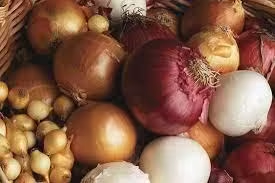
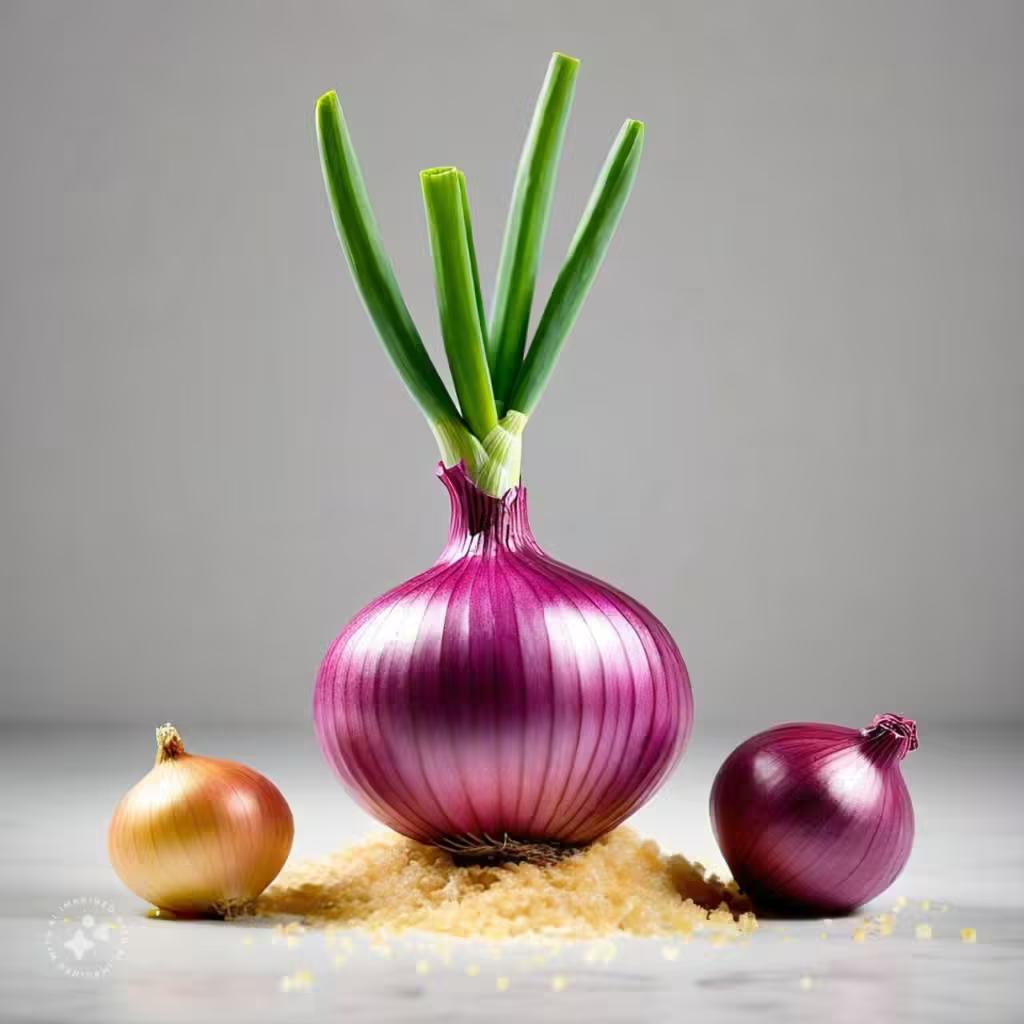
Yellow Onions:
These are the most versatile onions and are ideal for cooking. They have a strong flavor that mellows out when sautéed or caramelized, making them perfect for soups, stews, and sauces.
If you’re new to learning how to dice an onion, yellow onions are a great place to start.
Red Onions:
Known for their mild and slightly sweet flavor, red onions are best used raw in salads, salsas, and sandwiches.
Their vibrant color also makes them a great garnish. Knowing how to dice an onion like a red onion will help you create beautiful, colorful dishes.
White Onions:
These onions have a sharper and more pungent flavor than yellow or red onions. They’re commonly used in Mexican dishes like guacamole and salsas.
When learning how to dice an onion for Mexican cuisine, white onions are often the go-to choice.
Sweet anion
As the name suggests, these onions are sweeter and milder than other varieties. They’re great for raw preparations like burgers, sandwiches, or salads, where you want a less intense onion flavor.
Once you’ve chosen the right onion for your dish, it’s time to move on to the actual process of learning how to dice an onion.
Tools You’ll Need to Dice an Onion
Before diving into the detailed steps of how to dice an onion, you’ll want to gather the necessary tools.
Using the right equipment will not only make the process easier but also safer.
Here’s what you’ll need:
A Sharp Chef’s Knife:
A dull knife can crush the onion instead of cutting it cleanly, making it harder to achieve uniform dice.
A sharp knife will ensure smooth, precise cuts, and reduce the amount of sulfur compounds released, which can help reduce tears.
A Cutting Board:
Make sure you’re using a stable cutting board that won’t slip while you’re working. If your cutting board slides around, place a damp kitchen towel underneath to keep it secure.
A Bowl:
Once you’ve finished dicing your onion, you’ll need a bowl to hold the diced pieces. This is especially useful if you’re dicing multiple onions at once.
How to Dice an Onion: Step-by-Step Instructions
Now that you have your tools ready and have chosen the right type of onion, let’s get into the actual process of how to dice an onion. Follow these steps for perfectly diced onions every time:
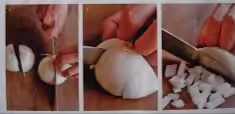
1. Peel the Onion
The first step in learning how to dice an onion is to peel it.
Start by cutting off the tip of the onion, which is the pointy end opposite the root. Be sure to leave the root intact, as it will hold the onion together while you dice it.
Once you’ve removed the tip, peel away the outer layers of skin. You may need to remove one or two additional layers if they’re tough or dry. Discard the skin and set the peeled onion on your cutting board.
2. Cut the Onion in Half
Next, you’ll want to cut the onion in half lengthwise, from the root end to the tip. Cutting the onion in half will give you two flat surfaces to work with, which provides stability while you’re dicing. Stability is crucial when learning how to dice an onion, as it helps prevent the onion from rolling around while you cut.
3. Make Horizontal Cuts
Now it’s time to start dicing. Holding the onion firmly, make several horizontal cuts from the root toward the top, but don’t cut all the way through the root.
The root will keep the onion intact while you make your cuts. If you want a finer dice, make more horizontal cuts. For a coarser dice, fewer cuts are needed.
4. Make Vertical Cuts
Once you’ve made your horizontal cuts, the next step in learning how to dice an onion is to make vertical cuts.
Again, start at the top of the onion and cut down toward the root, but don’t cut through the root itself.
The spacing of your vertical cuts will determine the size of your dice. For a finer dice, make the cuts close together. For a larger dice, space the cuts farther apart.
5. Dice the Onion
Finally, it’s time to complete the process of how to dice an onion. Starting at the top of the onion, slice across the horizontal and vertical cuts you’ve made.
As you slice, the onion will naturally fall into evenly diced pieces. Continue slicing until you reach the root, which you can discard or save for making stock.
Now you’ve learned how to dice an onion using the basic technique. But there are a few more tips and tricks that can help you refine your skills.
Advanced Tips for Dicing Onions
Once you’ve mastered the basic method of how to dice an onion, you can try these advanced tips to make the process even easier:
Chill Your Onion:
If you find that dicing onions always makes your eyes water, try chilling the onion in the refrigerator for about 15 minutes before cutting. Cold onions release fewer tear-inducing compounds, which can help minimize eye irritation.
Use a Rocking Motion:
When slicing through the onion, use a rocking motion with your knife. This will make your cuts smoother and more precise, and it can help prevent the onion from being crushed.
Practice Knife Skills:
Knowing how to dice an onion isn’t just about the steps—it’s also about how well you handle your knife. Practicing basic knife skills, like keeping the tip of the knife on the cutting board while lifting and lowering the handle, will help you become more efficient at dicing.
How to Dice an Onion Without Tears
One of the biggest challenges people face when learning how to dice an onion is dealing with the tears.
Onions release sulfur compounds when cut, which react with the moisture in your eyes to create sulfuric acid, causing a burning sensation and tears.
Here are some proven methods to reduce or avoid tears while dicing onions:
Use a Sharp Knife:
As mentioned earlier, a sharp knife will cause less damage to the onion’s cells, releasing fewer tear-inducing compounds.
Cut Near a Fan:
A small fan blowing across your cutting board can help disperse the onion fumes before they reach your eyes.
Refrigerate the Onion:
Cold onions release fewer sulfur compounds, reducing the chance of irritating your eyes. Chilling the onion for about 15 to 20 minutes in the fridge before cutting can make a significant difference.
Cut Under Water:
Some people swear by cutting onions under water or running water. This method helps wash away the sulfur compounds before they reach your eyes. However, this can be a bit tricky since working with water can make your cutting surface slippery, so proceed with caution.
Wear Goggles:
Although it may sound a bit extreme, wearing kitchen goggles designed for chopping onions or even swim goggles can create a seal around your eyes and prevent the onion fumes from reaching them.
By using any of these methods, you can make learning how to dice an onion a more pleasant experience, free from tears.
How to Store Diced Onions
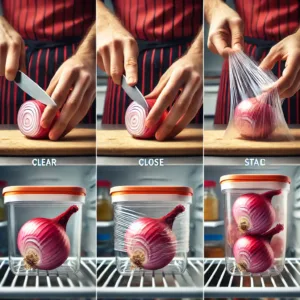
Once you’ve mastered how to dice an onion, the next question is often how to store them properly.
Freshly diced onions can be stored in an airtight container in the refrigerator for up to 7 days. To minimize the strong odor that onions tend to emit, make sure your container is well-sealed.
Some people prefer to place a layer of plastic wrap over the diced onions before sealing the container, which can further help reduce the smell.
If you’ve diced more onions than you can use within a week, you can also freeze them. Spread the diced onions on a baking sheet in a single layer and freeze them for a couple of hours.
Frozen diced onions can be stored for up to 3 months, and they’re perfect for adding to soups, stews, and casseroles without needing to defrost them first.
Troubleshooting Common Problems When Dicing Onions
Even once you know the basics of how to dice an onion, you might run into a few issues that can slow you down. Let’s troubleshoot some common problems and how to fix them:
Uneven Dices:
If your onion dice turns out uneven, the most likely culprit is inconsistent cuts. Make sure your horizontal and vertical cuts are evenly spaced. Practicing with slow, deliberate cuts will improve your technique over time.
Slippery Onion:
Onions can become slippery, making it difficult to hold onto them while cutting. If you’re struggling with this, try cutting slower and taking your time. Additionally, keeping your hands dry and using a sharp knife can help.
Cutting Too Deep:
One common mistake when learning how to dice an onion is accidentally cutting through the root end. The root is what holds the onion together, so it’s important to avoid slicing through it. Practice stopping just before the root with each cut.
Burning Eyes:
If you find yourself tearing up every time you cut an onion, consider switching up your method, as discussed earlier. Whether it’s chilling the onion, using a fan, or even wearing goggles, find the method that works best for you.
Recipes That Require Perfectly Diced Onions
Now that you know how to dice an onion, it’s time to put that knowledge to use.
Here are a few popular recipes that require diced onions:
Classic Tomato Salsa:
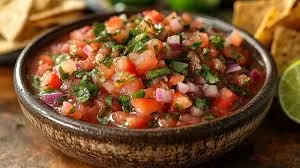
Diced onions add a fresh, crunchy texture to classic tomato salsa and balance out the sweetness of the tomatoes with their mild sharpness. To make this salsa, you’ll need finely diced onions, tomatoes, jalapeños, cilantro, lime juice, and salt. Your mastery of how to dice an onion will ensure a consistent texture that blends well with the other ingredients.
French Onion Soup:

A perfectly diced onion is key for making a rich, flavorful French onion soup. Slowly caramelizing the onions to bring out their sweetness is the foundation of this classic dish. Knowing how to dice an onion properly will help ensure even cooking and prevent some pieces from burning while others remain raw.
Guacamole:

Diced onions are essential for making authentic guacamole. They add a little crunch and a bit of bite to the creamy avocado base. A uniform dice ensures that every bite has just the right amount of onion, enhancing the flavor without overpowering it. When you know how to dice an onion, your guacamole will have that perfect balance.
Chili:
Whether you’re making a hearty beef chili or a vegetarian version, diced onions are usually one of the first ingredients to go in the pot. Their role in building the flavor of the dish is essential. Knowing how to dice an onion finely ensures the onions will break down properly and contribute to a smooth, well-seasoned chili.
Stir-Fries:
Onions are a common ingredient in many stir-fry dishes. In quick-cooking methods like stir-frying, it’s important that all ingredients are evenly cut to ensure they cook at the same rate. If you know how to dice an onion into even, bite-sized pieces, you’ll be able to make stir-fries that are both flavorful and visually appealing.
Health Benefits of Onions
Now that you know how to dice an onion and how to use them in various recipes, let’s talk about why onions are so great for your health. Onions are a low-calorie, nutrient-rich food that offers several health benefits. Here are just a few reasons to include more onions in your diet:
Rich in Antioxidants:
Onions contain a powerful antioxidant called quercetin, which helps fight inflammation and may reduce the risk of chronic diseases like heart disease and cancer.
Supports Digestive Health:
Onions are a good source of fiber, particularly a type of soluble fiber called inulin, which acts as a prebiotic. Prebiotics help promote the growth of healthy bacteria in your gut, improving digestion.
Improves Bone Health:
Some studies suggest that onions may help increase bone density and reduce the risk of osteoporosis, especially in postmenopausal women.
Onions have antibacterial properties that can help boost your immune system and fight off infections. Including onions in your diet regularly may help keep colds and infections at bay.
Regulates Blood Sugar:
The sulfur compounds found in onions can help lower blood sugar levels, making them a good addition to the diet for people with diabetes or those at risk of developing diabetes.
Final Thoughts
Mastering how to dice an onion is a fundamental skill for any home cook.
It may seem simple, but knowing the proper technique will save you time in the kitchen, improve the appearance and flavor of your dishes, and make cooking more enjoyable.
Whether you’re making a quick salad or a complex stew, knowing how to dice an onion correctly will ensure that you have uniform, perfectly cut onions every time.
Now that you’ve learned how to dice an onion step by step, gathered some tips to avoid tears, and discovered recipes that use diced onions.
With a little practice, you’ll be dicing onions like a pro, adding a new level of confidence to your cooking routine.
So grab your chef’s knife, an onion, and start practicing! You’ll be amazed at how much easier it becomes with time and how this basic skill will elevate your cooking to the next level.
